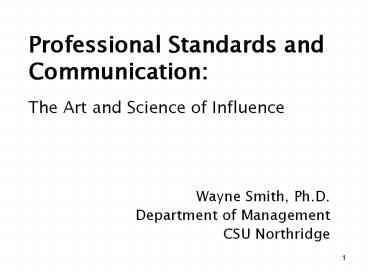Professional Standards and Communication: PowerPoint PPT Presentation
1 / 19
Title: Professional Standards and Communication:
1
Professional Standards and Communication
The Art and Science of Influence
- Wayne Smith, Ph.D.
- Department of Management
- CSU Northridge
2
The Influence Stack - Summary
Rhetoric
Logic
Prose
Composition
Philosophy
3
The Influence Stack - Detail
- Rhetoric
- performative reading
- privilege value
- contrast
- authority
- argument evidence
- Logic
- claim (assertion)
- reason (evidence?claim)
- evidence (facts)
- warrant (proposition)
- rebuttals qualifiers
- Prose
- rhythm
- pace
- emphasis
- feeling
- passion
- Philosophy
- theoretical basis
- trans-disciplinary mind
- sense- truth-making
- leverage prior work
- systematic approach
- Composition
- language use
- word choice
- grammar
- punctuation
- mechanics
4
The Influence Stack - Flow
compelling persuasion
Rhetoric
reasoned rationale
Logic
style/engagement
Prose
approach/strategy
Philosophy
syntax/semantics
Composition
5
The sine qua non of Professional Influence
- Accounting
- Expert Convention-as-Rule (e.g., matching
principle) - Economics
- Rationality-as-Rule (e.g., comparative
advantage) - Law
- Philosophy-as-Rule (e.g., common law, torts)
- Statistics
- Inference-as-Rule (e.g., central limit theorem)
- And of course, the same goes for Math
(Proof-as-Rule), Writing (Meaning-as-Rule),
Computer Literacy (Productivity-as-Rule), et al.
6
The sine qua non of Professional Influence
- Finance
- Return-on-Investment-as-Rule (e.g., risk/reward
trade-offs) - Operations
- Efficiency-as-Rule (e.g., minimal queuing
latency) - Management
- Leadership-as-Rule (e.g., self-efficacy,
emotional intelligence) - Marketing
- Consumer Behavior-as-Rule (e.g., exposed
preferences)
7
Argument and Logic
8
What is an argument?
- Claim (statement/assertion/solution)
- What should someone else do or believe?
- Reason (the strength of the Evidence supporting
the Claim) - Why should someone else agree with you?
- Evidence (quantitative data and qualitative data)
- What facts do you have? Are the facts accurate,
precise, representative, and reliable?
9
What is an argument?
- Warrant (logical proposition)
- What principle (theory/model/framework) makes
your Reasons relevant to your Claim? - Acknowledgement/Response (rebuttal)
- Have the readers/listeners questions or
alternatives been proactively identified? - Qualifier (conditions)
- Are the known limitations identified and
articulated?
10
An Argument that will Influence Professionals
2
Reason (your logic)
1
3
Evidence (premise)
Claim (conclusion)
4
Warrant (substantive theory)
5
6
Acknowledgement and Response (feedback)
Qualifications (conditions)
11
An Argument that will Influence Professionals
Interpretive Argument (judgment about
relevance)
2
Reason (your logic)
1
3
Evidence (premise)
Claim (conclusion)
4
Warrant (substantive theory)
5
6
Acknowledgement and Response (feedback)
Qualifications (conditions)
Vertical Argument (judgment about rigor)
12
What is an argument?
- Will the meaning of all words and sentences be
interpreted by all readers/listeners similarly? - Of all the possible causes of an event, 1), have
I identified the most important cause, and 2),
minimized as many cognitive biases as possible? - Have I overgeneralized (or underspecified)?
- Am I clear and unambiguous?
- Have I expressed values or evoked feelings?
- How can I augment the rational force of an
argument to address different points of view?
13
What isnt an argument?
- Coercion
- Makes the cost of rejecting a claim intolerable.
- Also, subtle coercion is still coercion.
- Propaganda
- The reasons dont have to be good, you dont care
what others think, and you play chiefly on
others emotions. - Also, a hidden agenda is still an agenda.
- Negotiation
- You can offer any reason you like, but
- 1), you dont generally disclose everything you
know about the reason, and - 2), it just needs to be good enough so that both
sides can live with the outcome of the
negotiation.
14
What Experienced Speakers Know about Making
Arguments
- The purpose isnt to win (prevail)
- The purpose is to solve an issue through
agreement - Coercion wont work
- Consider questions and objections of others and
respond - Good arguments and sound thinking isnt enough
- Constant re-thinking and re-evaluation will lead
to deeper and more substantive understanding - You cant invent a new form of argument each
time - You have to play to the audiences expectations
- Even if you dont win (prevail)
- A good argument earns the reputation of someone
with the qualities of reasonableness and
thoughtfulness
15
In-class Exercise
16
Sources
- Williams, J., and Colomb, G. (2007), The Craft of
Argument, 3rd ed., Pearson Education. - Parts of this presentation were inspired by one
of my former BUS 302 studentsMs. Shermineh
Maleki.
17
Back Pocket Slides
18
Rule--Lower-division core top ten topic
Secondary Source
Finding, Conclusion, Recommendation, Etc.
19
Below Market Rent

